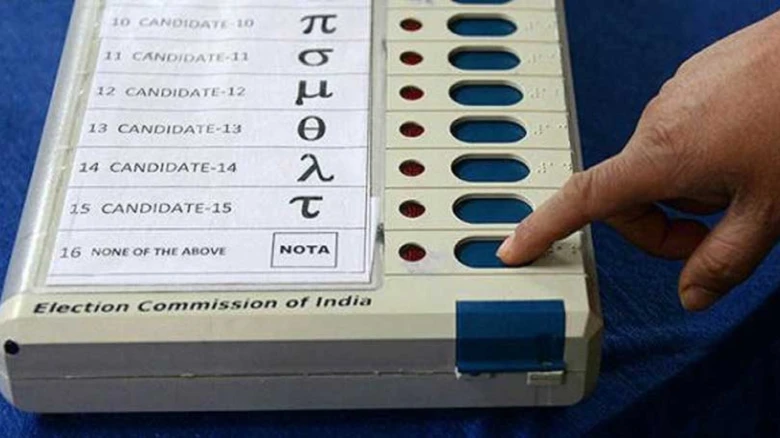A voter must hit the button next to the candidate's name or party symbol that is flashing on the EVM's screen...
Digital Desk: This Lok Sabha election marks the fifth time that Electronic Voting Machines (EVMs) have been used in India since 2004. This continues the country's transition away from the conventional vote paper system.
In the upcoming Lok Sabha elections, which will take place in seven stages starting on April 19 and with results announced on June 4, around 55 lakh electronic voting machines are anticipated to be in use.
Let's start by looking at some fascinating EVM facts.
To cast a vote, a voter must hit the button next to the candidate's name or party symbol that is flashing on the EVM's screen.
A maximum of 64 candidates (including NOTA) can be accommodated by the EVMs; 16 candidates can be accommodated per ballot unit. A second Balloting Unit may be connected in series with the first Balloting Unit if there are more candidates than 16.
The Upgraded Post-2006 version of EVMs made after 2013 may connect 24 ballot units to a single control unit, supporting up to 384 candidates (including NOTA).
Electricity is not needed for the EVMs, which were created and developed by the Election Commission in association with Bharat Electronics Ltd. in Bangalore and Electronics Corporation of India Ltd. in Hyderabad. They are powered by a standard alkaline 7.5-volt power pack.
A maximum of 2,00 votes can be cast in the new EVM version (2006 model onwards) and 3,840 votes in the previous EVM version (2000-05 model).
Election results can be kept in the memory of the Control Unit of the Electronic Voting Machine (EVM) for up to ten years.
A distinct ID number is assigned to every Control Unit and Balloting Unit and is etched on each unit. To assist the running candidates and their representatives, a list of the ID numbers of the EVM (Balloting Unit & Control Unit) to be utilized in a particular polling station is prepared.
The officer overseeing the Control Unit hits the "Close" button once the poll is over and the final voter has cast their ballot. Once this is done, the EVM does not accept any more votes.
Reprogramming the EVMs to support a certain candidate or political party is not a possibility. A "decoder" is a gadget that the ECI-EVMs use to determine who casts a vote for whom.
The 1989–1990 EVM model cost Rs 5,500/-per unit, and the 2000–05 versions increased that figure to Rs 8,670/-per unit. An EVM costs Rs 8,670 per unit, excluding excise duty, sales tax, and transportation, as of 2006.
HOW ARE EVMS DIFFERENT FROM VVPAT?
In 2013, the Voter Verifiable Paper Audit Trail (VVPAT) system was added to the Conduct of Election Rules, 1961. They were first utilized in the byelection for the Noksen assembly seat in Nagaland.
An EVM consists of a minimum of one ballot unit, one control unit, and one VVPAT. By printing a slip of paper with the voter's selection on it, the VVPAT machine, which is mounted to the ballot unit of an EVM, offers a visible confirmation of the vote cast.
The voter has seven seconds to confirm their vote on the slip, which is shown in the machine behind a glass window and includes the candidate's name, serial number, and party symbol.
VVPAT slips are matched with the EVM count and are selected at random from five voting places in each constituency as of 2019. The EC states that no discrepancy has been discovered thus far.
According to an EC affidavit filed with the Supreme Court in 2018, the EC requested that the Indian Statistical Institute (ISI) develop a “mathematically sound, statistically robust and practically cogent sample size for the internal audit of VVPAT slips with electronic results of EVMs”.
The EC approved the counting of VVPAT slips in February for one randomly chosen polling place per Assembly constituency. After the Supreme Court's ruling in response to a petition brought by Telegu Desam Party (TDP) leader N Chandrababu Naidu, this was raised to five.
BRICKBATS OVER EVMS
For more transparency, the opposition—primarily the INDIA bloc—has continuously insisted that the slips in every constituency be compared with the EVM count. The parties have requested that VVPAT slips be verified between 50% and 100%. However, the government has made it clear that the ballot method will not be reinstated.
Rajiv Kumar, the Chief Election Commissioner (CEC), recently made it clear that the Election Commission bears the burden of persuading political parties.
Former CEC Sunil Arora brought attention to how the political parties have cleverly exploited the EVM problem. EVM manipulation is not feasible. Concerning suspicions of manipulation and conspiracy, they are unquestionably impenetrable. However, just as with any other gadget, there could be technical issues," he stated.

Leave A Comment